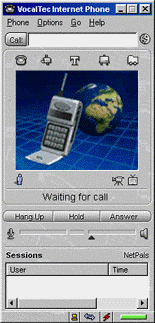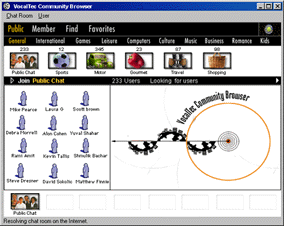![]() Internet Phone™ Release 5 sets the new
standard in Internet communication software with enhanced audio
and video quality and a revolutionary Internet Phone-to-Telephone
calling feature. With its expanded suite of multimedia features,
such as a live video, voice mail, a whiteboard, text chat and
file transfer, Release 5 provides a comprehensive solution for
your Internet/Intranet communication needs.
Internet Phone™ Release 5 sets the new
standard in Internet communication software with enhanced audio
and video quality and a revolutionary Internet Phone-to-Telephone
calling feature. With its expanded suite of multimedia features,
such as a live video, voice mail, a whiteboard, text chat and
file transfer, Release 5 provides a comprehensive solution for
your Internet/Intranet communication needs.
The new Community Browser™ makes it easy to find people
with similar interests from around the world.
Whether you're calling a family member, business associate or just looking for a new friend in another part of the world, Internet Phone will connect you in a way you never thought possible. Now, more than ever, there is no need to worry about long distance, the whole world is just a local call away!
Internet Phone window is the
communication tool for making calls. The Community Browser™
is a real-time directory of on-line Internet Phone users.
Open the Community Browser and use it to select users to call.
Conduct the conversation from the Internet Phone window.
The Internet Phone window provides tools for making a call and performing other calling functions. In the Internet Phone window, you can:
| Call other people by typing their e-mail, IP or Internet Phone address in the Call Line. |  |
|
| Call a regular telephone using the Dialer. | ||
| Add Multimedia Features to your calls such as sending and receiving video, voice mail, text chat, whiteboard session, and file transfer, see Multimedia Sessions | ||
| View the Animated Assistant for information about your call. | ||
| See the User Information of the person you are speaking with. | ||
| Control the Video Settings. | ||
| See the status of your call in the Message Line. | ||
| Perform calling functions such as Answer, Hold, Hang Up, answer to Call Waiting, Redial, and Return Call. | ||
| Control the Audio Settings. | ||
| Keep a record of recent calls in the Session list and redial anyone you want. | ||
| Maintain a list of NetPals who you may want to call more often. | ||
| Find more information by the Status Indicators: do you share data with the other person, what is your conversation mode (half-, full-duplex), are you connected to the addressing server and what is your Internet connection quality. | ||
| Click the connection quality indicator to view incoming and outgoing audio and video Statistics. |
The Community Browser window provides access to virtual communities, or chat rooms, in which you can search for and contact people who share similar interests.
In the Community Browser window, you can:
| Search and call people in Public Chat Rooms, which VocalTec maintains for Internet Phone users. |  |
|
| Search and call people in Member Chat Rooms that you and other Internet Phone users create. | ||
| Create your own public or private chat room, adding textual and graphic web content to supplement the chat room's topic. | ||
| Create a list of your Favorite chat rooms. | ||
| Search for a person to call in a user directory. | ||
| Participate in an on-line conference. |
You are now ready to make your first call. Perform the following procedure to make an Internet Phone call from the Community Browser window.
To make your first call
Double-click the person's name. Right-click the person's name and then choose Call.
Click the Hang Up button in the Internet Phone window. Point to User in the Phone menu and choose Hang Up.
The conversation ends.
For other ways of making a call, see Additional Ways to Make a Call.
There are two modes of conversation: Full-Duplex and Half-Duplex. In a full-duplex conversation, both users can speak at the same time; in a half-duplex conversation, users take turns speaking.
In order to be able to conduct a full-duplex conversation, both users' systems must support full-duplex mode. A full-duplex sound card must be installed. If your system supports full-duplex mode, but the other user's system supports only half-duplex mode, Internet Phone will automatically switch to half-duplex.
During a conversation you can switch between full-duplex and half-duplex mode at will.
To switch between full-duplex and half-duplex mode
Point to Audio in the Options menu and choose Full Duplex depending on your requirement:
| When selected: Full-duplex mode. If both users' systems support full-duplex, both of you can speak simultaneously. | |
| When cleared: Half-duplex mode - both of you must take turns speaking. |
At the bottom of the Internet Phone window, the Conversation Mode icon displays the current mode.
| NOTE If the mode automatically switched to half-duplex because the other user has only half-duplex capability, the conversation mode icon is changed, indicating that your system is now in half-duplex mode. This mode will last only during the current conversation. |
During a full-duplex conversation, both you and the other person can speak simultaneously, just as easily as if you were using a phone. Note that there can be a short delay before what you say is transferred and played on the other user's system.
The following events occur in the Internet Phone window:
| The Animated Assistant shows you are talking with each other. | ||||
| The Message line indicates the current mode of conversation. The different modes are: | ||||
| No
one is talking Nobody is speaking. You or the other person can start speaking. |
Talking What you say is transmitted over the Internet to the other person. |
Listening What he or she says is transmitted over the Internet to you. |
Both What you both say is transmitted over the Internet to each other. |
|
A half-duplex conversation is identical in nature to a full-duplex conversation, except for the following:
| No
one is talking You can start speaking. |
Talking Your voice is being transmitted over the Internet to the other person. |
Listening What the other person says is transmitted over the Internet to you. |
| NOTE Internet Phone sets full-duplex mode as the default value at Internet Phone startup. To set half-duplex mode as the default, choose Audio>Preferences from the Options menu. Click the Devices tab and clear the Use Full Duplex to start Internet Phone in half-duplex mode as the default. |
You can easily recognize an incoming call when:
| You hear a telephone ringing sound. | |
| The Animated Assistant shows that you are receiving a call. | |
| The Answer button text blinks in red. | |
| The Message Line displays the message Ringing. | |
| The caller's user information is displayed in the User Information section. | |
| A new entry is displayed in the Session list with a ringing telephone icon at its left. |
If you accept the call, the conversation with the other person starts. You can also see the name of the person who called you on the Internet Phone window title bar.
To accept an incoming call
| Click the Answer button or point to User in the Phone menu and choose Answer. | |
| Double-click on the new entry in the Session list. |
| TIP The Session list can help you track the calls from other users that arrived while you were in the middle of another conversation. After you disconnect, the names of the people who tried to call you appear on the Session list with a small grayed icon displayed to the left. You can return a call to a person by double-clicking on his or her name. |
To block all incoming calls, choose Do Not Disturb from the Phone menu.
The Do Not Disturb icon appears near the Message Line indicating you are in the Do Not Disturb mode.
Choosing this option allows you to conduct a conversation or perform other functions without any interruptions.
You can receive calls from specific people in the NetPals list even if the Do Not Disturb mode is active. See NetPals.
To disable the Do Not Disturb mode
Do one of the following:
| Click the Do Not Disturb icon. The icon disappears indicating you are no longer in the Do Not Disturb mode. | |
| Clear the Do Not Disturb command in the Phone menu. |
You can put the current session on hold if you want to call or answer someone else without disconnecting your current call. In the Session list you can maintain several on-hold sessions and move between them, keeping only one session active while the rest are on hold. The icon to the left indicates the status of each session.
To put the current session on hold
Do one of the following:
| During a conversation, click the Hold button. The text on the Hold button changes to Resume. | |
| Select another user from the Session list. |
To resume a session on hold
Do one of the following:
| Click the Resume button. | |
| Select a user on hold from the Session list and resume the conversation. |
When you are in the middle of a conversation and someone calls you, the text on the Answer button blinks in red and changes to Call Waiting. To answer a waiting call, click the blinking Call Waiting button. The previous conversation is automatically put on hold.
To mute your microphone, click the microphone icon on the Audio Settings.
Choosing this option when you are in a full-duplex mode prevents picking up background noise and interrupting the other person while he or she is speaking.
Information in
this document is subject to change without notice. No part of
this document may be reproduced or transmitted in any form or by
any means, electronically or mechanically, for any purpose, without the express written permission of
VocalTec Communications Ltd.
⌐ 1997 VocalTec Communications Ltd. All rights reserved.
VocalTec«, Internet Phone,
Community Browser, VocalTec Telephony Gateway and VocalTec
Conference Server are trademarks and registered trademarks of
VocalTec Communications Ltd.
All other trademarks are the property of their respective owners.
VIP 5 1st Edition — July 1997.